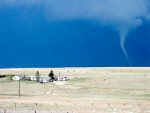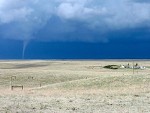Tuesday, May 18th started out as a lovely warm spring day at the Shortgrass Steppe (SGS) LTER--a welcome relief after a cold winter. But around mid-day severe weather warnings were posted for most of the Front Range – from well south of Denver to Cheyenne, Wyoming.
By 3 p.m., the weather looked sufficiently threatening to the west of Fort Collins and the Colorado State University campus that SGS LTER staff on campus checked the weather radar. There were two very bright and very tight storm cells over northern Colorado, just south of the Wyoming line and probably on top of our research site. Shortly after that the online news from Denver’s Channel 9 TV posted pictures taken in Cheyenne of a tornado on the ground to the south, probably in northern Colorado.
Meanwhile, back at the SGS LTER field site, Mark Lindquist and the 26 participants in the Rocky Mountain Sustainability and Science Network Summer Academy being held at the new SGS Research Interpretive Center (across the county road from the SGS LTER headquarters) were standing on porches watching the sky. There was plenty of rain and some wind. Mark says he “noticed these huge cells forming” and went to check the National Weather Service (NWS) online. He discovered that NWS “had posted tornado watch and then warning for our immediate area,” he said.
Mark went back outside to check on the storms and saw what he describes as “clouds rotating with a tail forming.” He grabbed his camera from the field station and started taking pictures as the tornado moved east to west over 30-45 minutes before dissipating. Using binoculars, he could see rotation clearly and debris being thrown around. Although he thought the tornado was on the ground about 7-10 miles north of the SGS LTER headquarters building, NWS storm track information later indicated that the twister was only 2-3 miles north of the field station.
There were at least four additional tornados and potential tornado-generating storm cells later that afternoon and evening. Around 6 p.m. Mark reported that there had been other storms going around the station and over it, but nothing as severe as the tornado in the afternoon. Although we were all relieved that no injuries or damages were reported after it was all over, Mark says these severe storms emphasize the importance to field researchers of paying attention to the conditions around them, not only their research subjects and activities.

 Enlarge this image
Enlarge this image
